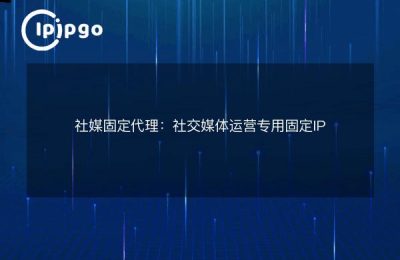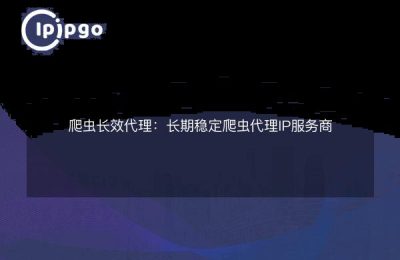
What is an IP Proxy?
An IP proxy is a method of forwarding requests through an intermediate server that can help you hide your real IP address for anonymous access or to bypass some simple network restrictions. Imagine that you wear a mask in the online world and all others see is the IP address of the proxy server, not your real identity.
Using the Proxy Class in Java
Implementing IP proxies in Java is really not that complicated.Java provides a built-in Proxy class that allows you to easily set up an HTTP or SOCKS proxy. Let's look at a simple example of how to use this class.
HTTP Proxy Example
First, let's look at a sample code for sending a request through an HTTP proxy:
import java.net.InetSocketAddress;
import java.net.
import java.net.URL; import java.net.
import java.net.HttpURLConnection; import java.net.
public class HttpProxyExample {
public static void main(String[] args) {
try {
// IP and port of the proxy server
String proxyHost = "123.45.67.89"; int proxyPort = 8080; int HttpProxyExample
int proxyPort = 8080;
// Destination URL
URL url = new URL("http://example.com");
// Create the proxy instance
Proxy proxy = new Proxy(Proxy.Type.HTTP, new InetSocketAddress(proxyHost, proxyPort));
// Open the connection
HttpURLConnection connection = (HttpURLConnection) url.openConnection(proxy); // Open the connection.
// Set the request method
connection.setRequestMethod("GET"); // set the request method.
// Get the response
int responseCode = connection.getResponseCode(); System.out.println("Response Code: " + responseCode); // Get the response.
System.out.println("Response Code: " + responseCode); // Get the response.
} catch (Exception e) {
e.printStackTrace(); } catch (Exception e) { e.printStackTrace(); }
}
}
}
In this example, we first create a Proxy object specifying the IP address and port number of the proxy server. Then, an HTTP connection is opened through this Proxy object and a GET request is sent. Finally, we fetched and printed the response code.
SOCKS Agent Example
Next, let's look at a sample code for sending a request through a SOCKS proxy:
import java.net.InetSocketAddress;
import java.net.
import java.net.
import java.io.InputStream; import java.io.
import java.io.OutputStream; import java.io.
public class SocksProxyExample {
public static void main(String[] args) {
try {
// IP and port of the proxy server
String proxyHost = "123.45.67.89"; int proxyPort = 1080; int SocksProxyExample
int proxyPort = 1080;
// IP and port of the target server
String targetHost = "example.com"; int targetPort = 80; // IP and port of the target server; // IP and port of the proxy server.
int targetPort = 80;
// Create the proxy instance
Proxy proxy = new Proxy(Proxy.Type.SOCKS, new InetSocketAddress(proxyHost, proxyPort));
// Create the socket
Socket socket = new Socket(proxy);
socket.connect(new InetSocketAddress(targetHost, targetPort)); // Create a socket.
// Send the HTTP request
OutputStream output = socket.getOutputStream(); output.write("GET /ET"); // send the HTTP request.
OutputStream output = socket.getOutputStream(); output.write("GET / HTTP/1.1rn".getBytes()); // Send HTTP request.
output.write(("Host: " + targetHost + "rn").getBytes());
output.write("rrn".getBytes());
output.flush();
// Read the response
InputStream input = socket.getInputStream();
byte[] buffer = new byte[4096]; int bytesRead = input.
int bytesRead = input.read(buffer); while (bytesRead !
while (bytesRead ! = -1) {
System.out.write(buffer, 0, bytesRead); int bytesRead = input.read(buffer); while (bytesRead != -1) {
bytesRead = input.read(buffer);
}
// Close the connection
socket.close();
} catch (Exception e) {
e.printStackTrace(); } catch (Exception e) { e.printStackTrace(); } }
}
}
}In this example, we also create a Proxy object, but this time we specify the SOCKS proxy type. Then, a Socket connection is created through this Proxy object and manually sends the HTTP request and reads the response.
application scenario
IP proxy can come in handy in many scenarios. For example, you can use it to capture web page data to avoid being blocked by the target website; or simulate multiple user requests through the proxy to test the server's carrying capacity when performing load tests.
caveat
Although IP proxies can provide some anonymity, they are not foolproof. When using proxies, be sure to comply with relevant laws and regulations and do not engage in any illegal activities. In addition, choose a reliable proxy server and avoid using free proxies from unknown sources to avoid encountering security risks.
concluding remarks
With the above example, you have learned how to implement IP proxy in Java. Hopefully, this article will help you better understand and apply IP proxy technology to make your web requests more flexible and interesting.
What is an IP Proxy?
An IP proxy is a method of forwarding requests through an intermediate server that can help you hide your real IP address for anonymous access or to bypass some simple network restrictions. Imagine that you wear a mask in the online world and all others see is the IP address of the proxy server, not your real identity.
Using the Proxy Class in Java
Implementing IP proxies in Java is really not that complicated.Java provides a built-in Proxy class that allows you to easily set up an HTTP or SOCKS proxy. Let's look at a simple example of how to use this class.
HTTP Proxy Example
First, let's look at a sample code for sending a request through an HTTP proxy:
import java.net.InetSocketAddress;
import java.net.
import java.net.URL; import java.net.
import java.net.HttpURLConnection; import java.net.
public class HttpProxyExample {
public static void main(String[] args) {
try {
// IP and port of the proxy server
String proxyHost = "123.45.67.89"; int proxyPort = 8080; int HttpProxyExample
int proxyPort = 8080;
// Destination URL
URL url = new URL("http://example.com");
// Create the proxy instance
Proxy proxy = new Proxy(Proxy.Type.HTTP, new InetSocketAddress(proxyHost, proxyPort));
// Open the connection
HttpURLConnection connection = (HttpURLConnection) url.openConnection(proxy); // Open the connection.
// Set the request method
connection.setRequestMethod("GET"); // set the request method.
// Get the response
int responseCode = connection.getResponseCode(); System.out.println("Response Code: " + responseCode); // Get the response.
System.out.println("Response Code: " + responseCode); // Get the response.
} catch (Exception e) {
e.printStackTrace(); } catch (Exception e) { e.printStackTrace(); }
}
}
}In this example, we first create a Proxy object specifying the IP address and port number of the proxy server. Then, an HTTP connection is opened through this Proxy object and a GET request is sent. Finally, we fetched and printed the response code.
SOCKS Agent Example
Next, let's look at a sample code for sending a request through a SOCKS proxy:
"`java
import java.net.InetSocketAddress.
import java.net.Proxy;
import java.net.
import java.io.InputStream;
import java.io.OutputStream;
public class SocksProxyExample {
public static void main(String[] args) {
try {
// Proxy server IP and port
String proxyHost = "123.45.67.89";
int proxyPort = 1080;
// IP and port of the target server
String targetHost = "example.com";
int targetPort = 80;
// Create the proxy instance
Proxy proxy = new Proxy(Proxy.Type.SOCKS, new InetSocketAddress(proxyHost, proxyPort));
// Create sockets
Socket socket = new Socket(proxy);
socket.connect(new InetSocketAddress(targetHost, targetPort));
// Send an HTTP request
OutputStream output = socket.getOutputStream();
output.write("GET / HTTP/1.1rn".getBytes());
output.write(("Host: " + targetHost + "rn").getBytes());
output.write("rn".getBytes());
output.flush();
// Read the response
InputStream input = socket.getInputStream();
byte[] buffer = new byte[4096];
int bytesRead = input.read(buffer);
while (bytesRead ! = -1) {
System.out.write(buffer, 0, bytesRead);
bytesRead = input.read(buffer);
}
// Close the connection
socket.close();
} catch (Exception e) {
e.printStackTrace();
}
}
}
“`
In this example, we also create a Proxy object, but this time we specify the SOCKS proxy type. Then, a Socket connection is created through this Proxy object and manually sends the HTTP request and reads the response.
application scenario
IP proxy can come in handy in many scenarios. For example, you can use it to capture web page data to avoid being blocked by the target website; or simulate multiple user requests through the proxy to test the server's carrying capacity when performing load tests.
caveat
Although IP proxies can provide some anonymity, they are not foolproof. When using proxies, be sure to comply with relevant laws and regulations and do not engage in any illegal activities. In addition, choose a reliable proxy server and avoid using free proxies from unknown sources to avoid encountering security risks.
concluding remarks
With the above example, you have learned how to implement IP proxy in Java. Hopefully, this article will help you better understand and apply IP proxy technology to make your web requests more flexible and interesting.








